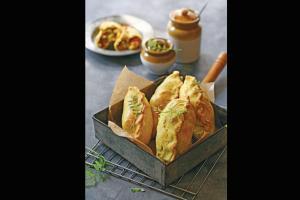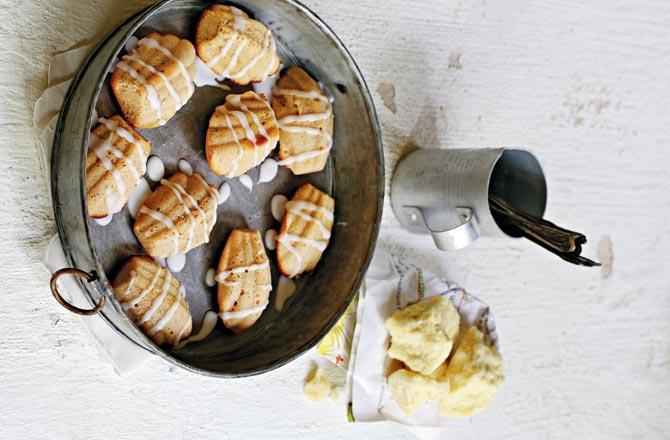In her new book, journalist Pamela Timms marries traditional Scottish treats with Indian desserts to create a range of easy, wholesome baking recipes

Pickle pies, a recipe that blends Indian pickle with Cornish pastry, a small English pie filled with meat and vegetables
When Scottish journalist Pamela Timms came to India in 2005 with her husband and three children, it was meant to be a short stint. But, they would soon settle down in the capital, a far cry from the cool environs of Scotland. While she fell in love with the syrupy jalebis and airy aloo tikkis, what she missed was baking cakes. "My need to bake was huge, but I had to contend myself with things I could make on the stove, like Welsh cakes and scones," she says.
The recipes from her early years and the ones she later mastered in India have made their way to her new book, Uparwali Chai: The Indian Art Of High Tea (Penguin India). From mulberry meringues and cape gooseberry jam tarts to carrot halwa muffins and besan laddoo cookies, the recipes are an ode to "the hug-in-a-bowl fare of mothers,
grandmothers and aunts".
Edited excerpts from the interview.
What inspired you to write Uparwali Chai?
I've loved baking and making afternoon tea. It's such a treat. When I came to live in India, I had an opportunity to incorporate lots of new Indian flavours in my baking. So, in 2009, we started high tea events called Uparwali Chai, where I teamed up with a Dutch friend to create an India-inspired menu of cakes and pastries. Some of the recipes are culled from the pop-ups. The book is an attempt to recreate the nostalgia and the food of my early, impressionable years.

Pamela Timms
After moving to Delhi, you had very little baking equipment. Did that change your approach towards baking?
I had to focus on the very simple recipes, partly because of the lack of cake tins, mixers, etc., but also because I didn't have a great oven at that time. The recipes at the beginning of the book, including yogurt cake, which uses a yogurt pot to measure ingredients, are a product of that time. Contrary to popular perception, it's not essential to have a top-of-the-range German oven or a swanky kitchen aid mixer. In fact, everything in this book was first made with no more than an inexpensive hand-held electric mixer and an electric OTG (over, toaster, grill). I've even heard about inventive Indian cooks rustling up cakes in pressure cookers in an empty Dalda can. Although I haven't tried it, I did try to bake on a desi gas, but it was not my finest experience.
How did you decide on the recipes?
These are quite simply my favourite baking recipes of all time. They reflect the baking I grew up with. As a child, Saturday was baking day, with my mother spending hours making biscuits, scones and doodlebugs, which are essentially chocolate cornflake cakes. My favourite was the Scotch pancakes or the 'drop scones', airy, buttery and topped with homemade raspberry jam. Another childhood delight were the doodlebugs that most people know as chocolate crispy cakes. You don't even need an oven.
How was the Uparwali Chai menu curated?
We would tweak it according to the occasion and venue. A tea party for Gandhiji's birthday featured salted caramel macarons. Much to our delight, the event was a hit from the very first day. Every event was sold out within minutes of announcing it on Twitter. I realised Indians love tea and cakes just as much as the British. We've held them everywhere from my roof to Sanskriti Kendra, to Yum Yum and Tree Gunpowder.
How did India influence your cooking?
We eat a lot more Indian dishes now. And I'm quite taken in by the concept of andaaz. The apple and Old Monk 'andaaz' cake with marmalade cream is a recipe that requires no baking equipment or special ingredients. It's a celebration of approximation, especially weights and measures, in the kitchen. However, I recommend investing in scales if you are keen to explore home baking. Another takeaway is my love for Indian mithai. I'm virtually incapable of baking without a bit of varq (silver leaf). There is also a cake inspired by the summer drink Rooh Afza. The mawa madeleines, an Indianised British sponge cake, is a shoutout to Mumbaikars. I first came across the mawa cake at Britannia restaurant and I remember being underwhelmed. It looked like the plainest of sponge cakes. But, as we know, looks can be deceiving.
What's the main difference between Scottish high tea and the way Indians drink chai?
I think British afternoon teas can be quite similar—sandwiches, scones, cakes and a pot of tea. Whereas, Indian teatime is a lot more flexible and innovative.
Mawa Madeline
Ingredients
(For the mawa, or khoya)
1 litre full cream milk
(For the madeleines)
150 gm all-purpose flour
1 tsp baking powder
Seeds of 4 green cardamoms, finely ground
100 gm mawa
100 gm butter
100 gm caster sugar
2 eggs, lightly beaten
75-100 ml milk
You will need a madeleine mould or a cake tin and paper cake cases

Method
Grease a madeleine mould with melted butter or line a muffin tray with small cake cases.
If you have to make the mawa, you will need to think ahead as the process takes up to 2 hours.
Put the milk into a large, heavy-bottomed pan and slowly bring to the boil. Turn down the heat and let the milk simmer gently. Stir regularly to make sure it doesn't stick to the pan and burn. Eventually the milk will darken slightly in colour and thicken.
Once it resembles the thickness of porridge, don't take your eye off it—stir continuously until all the liquid has evaporated and you're left with about 150 gm mawa. This can then be stored for a few days in the refrigerator or months in the freezer. Bring it to room temperature before you use it to make mawa cakes.
When you are ready to make the cakes, preheat the oven to 180°C. Sift together the flour, baking powder and ground cardamom in a large bowl.
Put the mawa, butter and caster sugar in another bowl and beat until light and fluffy. Gradually add the eggs, beating well to incorporate them into the mixture. Mix in the flour mixture and enough milk to make a mixture that drops off a spoon banged on the side of the bowl.
Divide the mixture into madeleine moulds or cake cases. Bake the cakes for about 10 to 15 minutes, until they are lightly browned on top and a skewer inserted into the middle comes out clean.
They are perfect fresh and warm from the oven with, what else, a glass of milk.
Catch up on all the latest Mumbai news, crime news, current affairs, and also a complete guide on Mumbai from food to things to do and events across the city here. Also download the new mid-day Android and iOS apps to get latest updates
 Subscribe today by clicking the link and stay updated with the latest news!" Click here!
Subscribe today by clicking the link and stay updated with the latest news!" Click here!









